Website Design & Development
Transform Your Online Presence with Our Comprehensive Web Design and Development Services
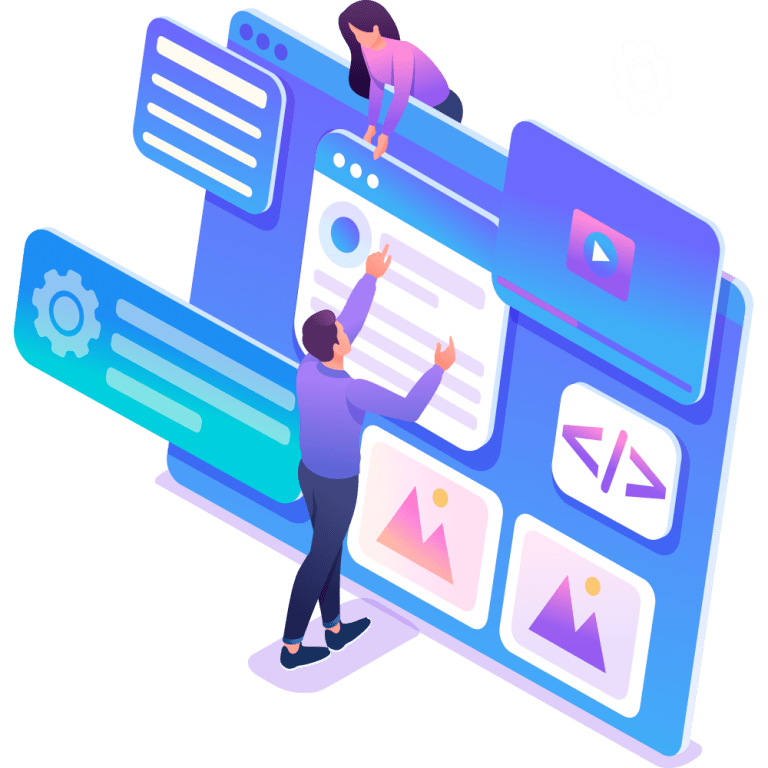

Our Web Design & Development Process
Our Web Design & Development Process – A Solution for Your Business. As an Edmonton web developer, we understand the importance of having a website that truly represents your business. A website that is well-designed, functional and tailored to your specific needs can help you attract more customers, generate more leads, and increase your revenue. At our website design company, we specialize in providing web design and development services that help businesses stand out from the competition. Our team of experts works closely with you to understand your business goals and create a website that not only looks great, but also provides a seamless user experience. As a leading website company, we use the latest technologies and design trends to create custom business web designs that are not only aesthetically pleasing, but also perform well on search engines. Our focus is on creating a website that delivers results and drives business growth. When it comes to choosing the best web design company for your business, it’s important to look for one that has a proven track record of delivering high-quality websites. Our website design firm has a reputation for creating innovative and effective websites for businesses of all sizes, making us a trusted choice for web design and development services. At our website design company, we understand that website design is not just about aesthetics, but also about marketing. That’s why we offer web design marketing services that help you reach your target audience and drive conversions. Whether you need a new website or a redesign of your existing site, we’re here to help you achieve your business goals.
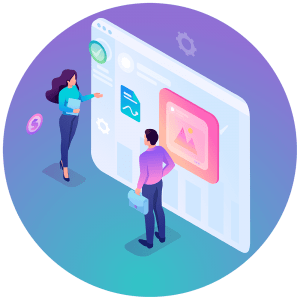

Step 1:
Understanding Your Business and Website’s Goals and Situation
Our experienced team of Edmonton web developers and website design experts will work closely with you to understand your business goals and situation. We will conduct a thorough needs assessment to determine the purpose of your website, target audience, and main objectives. With this information, we can design and develop a tailored website that meets the unique needs of your business and customers. Our web design and development services are designed to provide scalable, practical, and functional solutions that will help you maximize your online potential and achieve your business goals.
Step 2:
Competitor Analysis
Our team takes a deep dive into your industry to understand the competitive landscape and identify what sets you apart from the rest. Through competitor analysis, we gather insights on the best web design and development strategies to help your business stand out in the market. We use this information to create a unique, practical, and functional website that sets you apart from the competition and serves your customers’ and business’ needs.
Some of the competitor attributes we look at include:
- Tech & Tools
- Site Structure Analysis
- Website Speed & Performance Metrics
- Backlink Tracking & Analysis
- General Usability, Branding & Site Analysis
We compile all of this data together to develop an effective strategy to surpass your competition. A deep understanding of your industry allows us to plan for success.
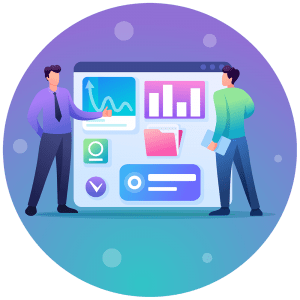

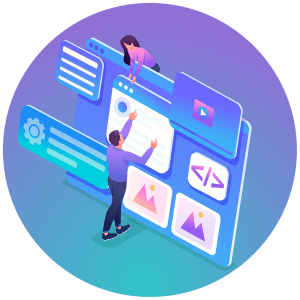

Step 3:
Planning, Sitemap & Wireframe Creation
Our team of experts in web design and development will use the sitemap, wireframe, and information gathered in the previous steps to create a custom website design that represents your brand and resonates with your target audience. Our focus will be on providing an intuitive user experience, clean design, and fast-loading pages to ensure a seamless and enjoyable browsing experience for your visitors. Our custom web design and development services are tailored to meet the unique needs of your business and achieve your desired goals.
Step 4:
Design: Page Layouts, Review, and Approval Cycle
This is the stage where your website truly comes to life. Our team combines the information gathered in the needs assessment, competitor analysis, and planning phase to create a visually appealing, easy-to-navigate, and functional design that meets the needs of your target audience. We bring your brand to life through the use of relevant colours, images, and logos. As a website design company, customer satisfaction is our top priority, and we work closely with you to ensure that you are delighted with the final product before moving forward.
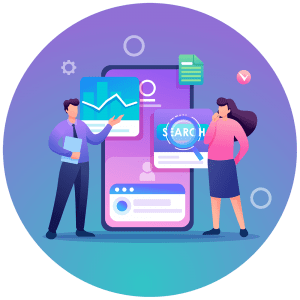

Get Started with Loop
Why work with Loop Strategic Marketing for your website design and development?
Project Management & Accountability
We set deadlines, and feedback loops that allow us to deliver results beyond your expectations. We get you the results you want, on time.
Constant Communication & Feedback
Feedback is everything, it is your business at the end of the day. If you don’t like something we are doing, we want to know. If you don’t understand why were are doing certain things, we want to explain it to you. Transparency and communication is the most effective way for your project to succeed.
Industry Leading Tools & Technology
The digital world is always changing, staying up to date with industry best practices is a full time job. We make it our mission to build our websites with up to date tools, software, and practices to ensure your project is a success.
Benefits of Our Website Design and Development Services
- CRM / Sales System integrations so you're never missing an opportunity
- SEO Optimized so your website can rank for your targeted keywords
- Strategic design & strategy to convert potential customers
- Copywriting & Content is created and curated by us
- Beautiful & functional designs
Frequently Asked Questions
Research their preferences, needs, and online behaviours to create a web design that resonates with your target audience. Understand the demographic characteristics such as age, gender, occupation, and interests. Tailor the design elements like colours, fonts, and imagery to match their expectations and enhance usability. Incorporate user feedback early in the design process through surveys or focus groups. Make navigation intuitive and ensure the content is engaging and relevant to their needs. By focusing on your audience’s preferences and pain points, you can create a design that appeals directly to them, increasing engagement and conversion rates.
Was this FAQ Useful?
Your website’s design should be updated every 2-3 years to stay current with design trends, technological advancements, and user expectations. However, more frequent updates might be necessary based on performance analytics, user feedback, or significant changes in your business or industry. Regular updates ensure your site remains competitive, relevant, and secure. Additionally, updating your design can improve user experience, support SEO strategies, and address any usability issues. It’s also an opportunity to refresh your content and ensure that your website accurately reflects your brand’s message and values.
Was this FAQ Useful?
There’s no hard and fast rule for how often you should replace your website. However, we generally recommend doing a full redesign every two to three years, or making smaller updates (such as adding new pages or updating your design) on a more frequent basis. If you’re not sure whether or not it’s time for a new website, reach out and we can chat about it further.
Was this FAQ Useful?
Effective web design is built on several fundamental principles: simplicity, navigation, responsiveness, consistency, accessibility, and visual hierarchy. Simplicity involves using clean, uncluttered layouts that focus on essential elements, making it easier for users to interact with your site. Navigation should be intuitive, allowing users to find information quickly and easily. Responsiveness ensures your site is accessible on various devices and screen sizes. Consistency in design elements and layout improves usability and brand recognition. Accessibility means your site is usable by people of all abilities and disabilities. Lastly, visual hierarchy guides the user’s attention to important information first. These principles work together to create a user-friendly, engaging, and effective website.
Was this FAQ Useful?
There are several ways in which a website can help improve your credibility:
- Professional appearance: A well-designed website with a professional appearance can help establish credibility and trust with your audience. Customers are more likely to trust businesses with websites, and a polished website can make your business look more legitimate and trustworthy.
- Up-to-date information: Having a website allows you to easily share important information about your business, such as your products or services, contact details, and location. This can help establish credibility and show customers that you are a reliable and professional business.
- Customer reviews and testimonials: A website can provide a platform for customers to leave reviews and testimonials about your business. These reviews can help build credibility and trust with potential customers, as they can provide valuable insights into the quality of your products or services.
- Industry credentials and awards: If you have industry credentials or have won awards for your business, a website can be a great place to showcase them. This can help establish credibility and differentiate your business from the competition.
Overall, a website can be an effective tool for improving your credibility and building trust with your audience. By providing a professional-looking platform to share information about your business and customer reviews, you can establish yourself as a reliable and trustworthy choice for potential customers.
Read more about why your business needs a website.
Was this FAQ Useful?
Here are a few tips for ensuring that your website has the best user experience:
- Keep it simple: A cluttered or overly complex website can be overwhelming and confusing for users. Instead, focus on creating a clean, easy-to-navigate design that clearly communicates your message.
- Use clear, concise language: Your website should be easy to understand, even for visitors who may not be familiar with your business or industry. Avoid using jargon or technical language, and aim for a clear, concise writing style.
- Use high-quality images: Visuals are an important element of website design, as they can help convey your message and create a more engaging user experience. Use high-quality images that are relevant to your business and add value to your website.
- Optimize for mobile devices: More and more people are accessing the internet on their smartphones and tablets, so it’s important to design a website that is mobile-friendly. This means ensuring that your website is easy to read and navigate on smaller screens.
- Test and optimize: Continuous testing and optimization can help you identify and fix any issues that may be impacting the user experience of your website. This can include A/B testing different design elements, analyzing user behavior, and gathering feedback from users.
By following these tips, you can create a website that delivers a positive user experience and meets the needs of your users.
Was this FAQ Useful?
The success of your website design can be measured through various metrics and tools. Analyze user behavior with analytics tools like Google Analytics to track metrics such as bounce rate, time on site, and conversion rates. High engagement and low bounce rates often indicate effective design. User feedback through surveys or usability tests can provide direct insights into the user experience. SEO rankings for your target keywords can indicate how well your design supports search engine optimization. Load time and mobile responsiveness metrics are also crucial for evaluating the technical performance of your design. Regularly reviewing these metrics can help you understand the impact of your design on user behavior and business goals.
Was this FAQ Useful?
Here are a few of the latest trends in web design and development:
- Responsive design: With more and more people accessing the internet on their smartphones and tablets, it’s important to design websites that are optimized for these devices. Responsive design is a design approach that ensures that a website’s layout and content are optimized for different screen sizes and devices.
- Material design: Material design is a design language developed by Google that focuses on creating a consistent, cohesive user experience across all devices. It emphasizes the use of flat design and intuitive, natural interactions.
- Minimalism: Minimalist design involves using a minimal amount of elements, such as text and images, to create a clean and uncluttered look. This trend emphasizes simplicity and functionality, and is particularly popular in web design.
- Microinteractions: Microinteractions are small, interactive design elements that add functionality and personality to a website. Examples include hover effects, loading animations, and notification alerts.
- Artificial intelligence and machine learning: Artificial intelligence (AI) and machine learning are being increasingly used in web design and development to improve the user experience and automate tasks. For example, AI can be used to personalize website content and make recommendations based on user behavior.
These are just a few of the latest trends in web design and development. It’s important to keep an eye on these trends to ensure that your website stays current and relevant. However, it’s also important to consider your own business goals and needs when designing and developing your website, rather than simply following the latest trends for trend’s sake.
Was this FAQ Useful?
It has never been easier to create a website on your own. There are so many tools that exist that offer plug-and-play/drag-and-drop editors for people to build their own sites. GoDaddy, Wix, Squarespace, WordPress, Shopify etc. The options are endless.
The choice you have to make for whether you want to build a website yourself is:
- Time – do you have the time to learn?
- Knowledge – do you have the technical knowledge to build a site that is engineered to accomplish what you intend?
- Ongoing Resources – do you have the future time/energy to commit to maintaining and keeping the website current/effective
Building websites in-house can be the right starting point for many businesses. Once your business picks up some momentum, at that point it usually makes sense to offload to a professional, unless you have a team that is trained, experienced, and does have more pressing tasks on their list for the business.
Was this FAQ Useful?
When looking for a website design company, it’s fairly simple. Look for these things:
- Experience – what work can they show you
- Trust – do you feel like they are someone who is honest and trustworthy
- Alignment – do they align with your business goals
Was this FAQ Useful?
A web design company typically offers a range of services including website design, website development, e-commerce development, content management systems (CMS), digital marketing, and search engine optimization (SEO). Some web design companies also offer additional services such as graphic design, branding, and website maintenance.
Was this FAQ Useful?
There are several ways in which a website can help you sell more products or services online:
- Online store: A website can serve as an online store, allowing customers to browse and purchase your products or services directly from your website. This can be especially useful if you have a small or niche business, or if you sell products that are not widely available in physical stores.
- Product information: A website can provide detailed information about your products or services, including photos, descriptions, and pricing. This can help customers make informed purchasing decisions and increase the chances of them buying from your business.
- Customer reviews and ratings: A website can provide a platform for customers to leave reviews and ratings about your products or services. These reviews can be a powerful tool for convincing potential customers to buy from your business, as they provide valuable insights into the quality of your offerings.
- Payment options: A website can offer a variety of payment options, such as credit card, PayPal, and Google Pay, which can make it easier for customers to complete their purchases.
- Customer service: A website can provide a platform for customers to get in touch with you and ask questions about your products or services. This can help address any concerns they may have and increase the chances of them making a purchase.
Overall, a website can be a valuable asset for businesses looking to sell more products or services online. By providing a platform to showcase your offerings, offer detailed product information, and provide customer service, you can increase the chances of customers buying from your business.
Read more about why your business needs a website.
Was this FAQ Useful?
A CMS is a Content Management System. This is the platform your website is built on. Common examples of CMS’ would be WordPress, Wix, Squarespace, Shopify, etc.
Was this FAQ Useful?
Working with a web design and development company can provide several benefits for your business, including:
- Increased online visibility and exposure
- Improved user experience for your website visitors
- Increased credibility and professionalism for your brand
- Ability to effectively showcase your products or services
- Better search engine optimization for your website, resulting in higher search engine rankings and increased traffic.
Was this FAQ Useful?
There are a few ways to tell if your website SEO is working. One way is to track your website traffic over time. If you see a steady increase in the amount of traffic coming to your site, that’s a good sign that your SEO efforts are paying off. Another way to tell if your SEO is working is by looking at your website’s search engine rankings. If you’re consistently appearing in the top results for relevant keywords, that’s also a good sign that your SEO is effective. Finally, you can track the number of leads and sales you’re getting from your website. If you see an uptick in these numbers after making changes to your website or implementing new SEO strategies, that’s a good indication that things are going well.
Was this FAQ Useful?
The cost of having a website designed and developed can vary greatly depending on a number of factors such as the complexity of the website, the number of pages, and the level of customization required. On average, the cost of a basic website can range from $2,500 to $5,000, while a more complex website can cost upwards of $10,000 or more.
Was this FAQ Useful?
Choosing the right web design and development company for your business is a crucial step in ensuring the success of your online presence. Here are a few important factors to consider when searching for the best web design company for your business:
- Define your needs: Before you start your search for a web design company, make sure you have a clear understanding of what you need from your website. This will help you find a company that is a good fit for your specific requirements.
- Look for experience and expertise: Choose a web design company with a proven track record of designing and developing successful websites. Ensure the company has experience in your industry and is knowledgeable about the latest design and development trends.
- Check the company’s portfolio: A company’s portfolio is a great indicator of its design and development skills. Look for a company that has a diverse range of projects in its portfolio and that has a style that aligns with your own.
- Get references: Ask the web design company for references from past clients and take the time to speak with them. This will give you a better idea of the company’s work style and whether it is a good fit for your business.
- Look for additional services: Some of the best web design and development companies also offer additional services such as SEO, digital marketing, and e-commerce development, which can enhance your website’s capabilities and attract more customers.
- Check for testimonials and reviews: Look for testimonials and reviews from previous customers to know about the company’s reputation and performance. Make sure the company has satisfied clients, good ratings, and reviews.
- Good customer support: A good web design and development company should provide excellent customer support, ensuring that any issues or problems you may have are resolved in a timely and professional manner.
By considering these factors, you can ensure that you are choosing the best web design and development company for your business. A best web design company can help you create a website that is both visually appealing and functional, helping you to achieve your business goals.
When searching for the best web design company, it is important to consider the company’s approach to web design. A company that has a clear and thorough understanding of user experience (UX) and user interface (UI) design is key to creating a website that is both aesthetically pleasing and easy to navigate. The best web design companies understand the importance of a well-designed website and will take the time to understand your business goals and target audience in order to create a website that effectively showcases your brand and meets your customers’ needs.
Another important factor to consider when choosing a web design company is their flexibility and ability to adapt to change. The digital landscape is constantly evolving and a best web design company should have the capability to adjust and evolve their designs to keep up with these changes. They should also be able to work with you to make changes and updates to your website as your business grows and evolves.
In conclusion, choosing the best web design and development company for your business is a crucial step in ensuring the success of your online presence. By considering factors such as experience, expertise, portfolio, additional services, testimonials and reviews, and customer support, you can be confident that you have found the right web design company to help you achieve your business goals.
Was this FAQ Useful?
There are many tools and technologies used in web design and development, and the best ones for your project will depend on your specific needs and goals. Here are a few popular options:
- Adobe Creative Cloud: Adobe Creative Cloud is a suite of tools for designing and developing websites, including Photoshop for graphic design, Illustrator for vector graphics, and InDesign for layout and typography.
- HTML and CSS: HTML (Hypertext Markup Language) and CSS (Cascading Style Sheets) are the building blocks of the web. HTML is used to structure and organize content, while CSS is used to style and layout web pages.
- JavaScript: JavaScript is a programming language that is commonly used to add interactivity to websites, such as animations and form validation.
- Content management systems (CMS): A CMS is a software platform that allows users to easily create and manage website content, such as text, images, and videos. Examples include WordPress, Joomla, and Drupal.
- Git: Git is a version control system that helps developers track and manage changes to their code. It allows developers to collaborate on projects and revert to previous versions if necessary.
Was this FAQ Useful?
The process for designing and developing a website typically includes the following steps:
- Determine the website’s goals and objectives
- Research and plan the website’s design and structure
- Design and create the website’s visual elements
- Develop the website’s functionalities and features
- Test and refine the website
- Launch the website and provide ongoing support and maintenance
Was this FAQ Useful?
Web development is the backbone of your online business presence, involving the coding and programming that powers a website’s functionality. It translates the web design into a live, working site. Developers use HTML, CSS, JavaScript, and other programming languages to bring the design to life, ensuring the site is responsive and performs well across different devices and browsers. Beyond aesthetics, development includes creating the architecture for managing content, securing the site against threats, and integrating with other systems like e-commerce platforms or customer relationship management tools. Effective web development ensures a seamless user experience, supports SEO strategies, and enables scalable, secure online business operations. It’s crucial for maintaining a website’s technical health and operability, directly impacting its success and the user’s satisfaction.
Was this FAQ Useful?
Let's see what you're working with
Tell us a bit about your business, and we will give you a few tips, tricks, and recommendations on the house.
Full Feature List
- Responsive Design
- Multi-Device Support
- Adapts to Every Screen Resolution
- Fully Customizable Design
- High Resolution
- Flexible & Versatile
- Fast Load Times
- Ongoing Support & Maintenance Available
- Smooth & Contemporary Design
- E-Commerce Support
- Fully Integrated into your systems
- Conversion Based Design
- On-Site SEO Strategy
- Content & Copy Writing
- Graphic Design
- Branding Packages & Styling Guides
- SSL & Security
- E-Commerce Support
